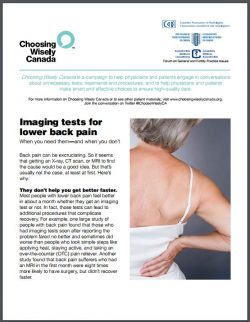Physicians “Choosing Wisely” with patients
Shortly after the national Choosing Wisely Canada campaign launched in 2012, a Steering Group was struck at Vancouver Coastal Health and Providence Health Care to explore ways to implement it in area hospitals.
Made up of physicians and administrators from across the two health organizations as well as a patient advisor, the group decided first to explore physician practice variation in exam ordering for medical imaging tests from the list developed by the Canadian Association of Radiologists (‘Five things physicians and patients should question’). Reasons for focusing here initially included highly engaged leadership and the fact that medical imaging tests showed up on a number of lists developed by other national societies.
Low Back Pain at St. Paul’s Hospital
One of the first Choosing Wisely projects rolled out at Providence Health Care’s St Paul’s Hospital (SPH) focused on imaging for low back pain. A multipronged strategy was used that included the implementation of a red flag alert in the form of a point of care checklist in the electronic ordering system, as well the creation of patient education materials.
“Low back pain is very a common presentation in the Emergency Department,” says Dr. David Agulnik, an Emergency Department physician at SPH and MSJ who helped with and co-authored the study. “There is often an expectation from patients that an x-ray will help with a diagnosis, but it isn’t always the case. The vast majority of low back problems improve without intervention, and unless there is indication that the pain could be symptomatic of a larger or more serious issue, we know that an x ray won’t actually improve diagnosis or getting better.”
When patients present with pain that doesn’t have any “red flags” – that is concerning signs or symptoms suggestive of a serious cause for their low back pain – they are given a Choosing Wisely pamphlet with their discharge summary that offers evidence-based information about their condition and explains why x-rays, CT scans or MRI scans aren’t offered every time. The patient information also provides general timeframes for when their condition should get better and outlines the next steps in the event that their condition does not improve, and offers suggested treatment options such as medications, physiotherapy and massage.
“It’s been a great teaching tool,” says Dr. Agulnik. “Having the booklet to give to patients provides them with reassurance about their condition – that it’s common, and that they won’t be abandoned just because we’re not ordering an imaging test.”
Having the booklet to give to patients provides them with reassurance about their condition – that it’s common, and that they won’t be abandoned just because we’re not ordering an imaging test.
Following the introduction of these interventions, the median proportion of low back pain patients who received a medical image significantly dropped from 22% to 17% while physician variation in ordering of images also decreased (mean imaging rate from 24% to 20%).*
Other Choosing Wisely initiatives
Working groups have also been looking into ordering CT scans for minor head trauma in the ED at Richmond Hospital, and CT scans for uncomplicated headaches at Lions Gate Hospital and outpatient referrals on the North Shore.
Based on this work, assessments will be conducted annually – starting this year – at a number of Emergency Departments across VCH and PHC on CT ordering for minor head trauma, uncomplicated headache and low back pain. Individual feedback will be delivered to emergency department physicians across the health authority as part of annual practice feedback.
Work is also underway at Vancouver General Hospital that is looking into reducing MRI examinations for patients over 55 years who have knee pain and co-existing osteoarthritis.
Dr. Bruce Forster, Regional Medical Director and Department Head of Medical Imaging for VCH-PHC and Professor and Head, Department of Radiology at UBC Faculty of Medicine, notes that for a number of common health issues, when certain red flags are not present, best practice tells us those patients do not benefit from tests and would be better served by following other management strategies. With respect to imaging modalities that have long wait times, as with MRI, exam slots are better saved for patients whose treatment plans will more likely be impacted by the imaging test result.
With respect to imaging modalities that have long wait times, as with MRI, exam slots are better saved for patients whose treatment plans will more likely be impacted by the imaging test result.
“The scientific literature shows us that patients with cartilage tears in the knee, who have co-existent moderate to severe degenerative arthritis do not benefit from having these cartilage tears surgically repaired.”
But, he goes on to say that we also must accept the reality of biology. Medicine is an art and a science with certain nuances that physicians are trained to identify and take into consideration when making decisions about the best plan of care for their patients. The goal of Choosing Wisely is not to be overly prescriptive but, rather, to reduce significant variability in care and provide patients with consistent care.
“If a physician working in the Emergency Department at ABC Hospital orders tests over a two week period in a manner that is markedly different than their colleagues, that difference may absolutely come from those individual nuances, Bruce explains. “Over a longer period of time, however – say six months – those variations should flatten out and, if they’re not, that’s likely an indication of a variation in care.”
“As we reduce unnecessary care, we can redirect resources and capacity to areas in MI with unmet demand,” says Bruce. “It can also help reduce ED congestion and help us to make better use of our healthcare resources.”
Toolkit
In an effort to share their learnings, Bruce worked with Vivian Chan, Director for Physician Quality Assessment and Improvement for VCH and PHC and Jeff Coleman, PHC ED physician and Physician Consultation Executive with MoH, to develop a toolkit for Choosing Wisely Medical Imaging. They presented it in February at a sold out, interactive session at the BC Patient Quality Forum. The toolkit is being reviewed by MoH who plans to make it available across the province.
The Steering Group also recently expanded their focus beyond Medical Imaging and is exploring lab utilization, particularly for blood work and transfusions, another area of great opportunity.
Key Learnings
“The two key lessons for me have been around the cultural aspects of these changes and the importance of good communications,” says Bruce, “To be successful, it’s critical that all health care workers, including physicians, nurse practitioners and administrators champion the changes, as should patient advocates. In addition, physicians and health care providers are busy professionals and we have to respect their workflow. This means interventions have to be quick, easy and seamless, and not cause a delay in seeing their patients.”
Choosing Wisely Canada
Choosing Wisely Canada is a national, clinician-led campaign to help patients and clinicians engage in conversations about unnecessary tests, treatments and procedures and make smart and effective choices to ensure high-quality care. Canadian Institute for Health Information (CIHI) partnered with Choosing Wisely Canada on the Unnecessary Care in Canada report which found that up to 30% of the tests, treatments and procedures associated with the 8 selected CWC recommendations are potentially unnecessary.
For more information check out Choosing Wisely Canada .
* Min A, Chan V, Aristizabal R, Peramkaki ER, Agulnik DB, Strydom N, Ramsey D, Forster BB. Clinical Decision Support Decreases Volume of Imaging for Low Back Pain in an Urban Emergency Department. Journal of the American College of Radiolgy. 2017. In press.



J Hammond
Are we giving these back pain pamphlets to patients who are elderly or who have heart or kidney disease? Is it a good idea to recommend NSAIDs to these patients?